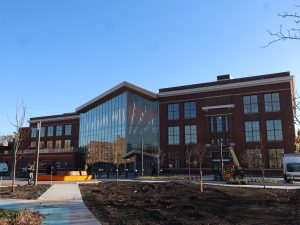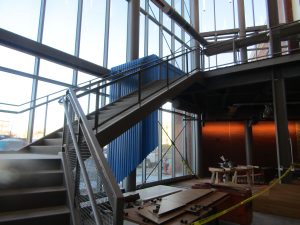Aspire Center to offer job training, support services on Chicago’s West Side
By Igor Studenkov for Chronicle Media — December 20, 2024
Conversion of the former Emmet Elementary School into Aspire Center is well underway, with the new glass-encased entrance being the most prominent sign. (Photo by Igor Studenkov/for Chronicle Media)
It took many years and many setbacks, but the transformation of the former Emmet Elementary School at the heart of Chicago’s Austin neighborhood into a job training and social services hub is now well underway.
When it opens in the spring of 2025, the Aspire Center is being positioned as more than just a place where West Siders can learn skills they would need to qualify for modern, advanced manufacturing jobs. It is meant to provide a supportive environment for residents who may be facing many obstacles, whether it’s something as relatively simple as finding affordable daycare for their kids, to something more complex, such as finding permanent housing or setting up bank accounts.
Austin Coming Together coalition and the Westside Health Authority will provide supportive services on site. The on-site BMO Harris bank branch will provide financial services, including financial literacy classes. Aspire Center will also be open to the community, offering space to host events or just hang out and work.
Chronicle Media was invited to an in early November tour of the building, along with several funders and community leaders. Many parts were still under construction, but the manufacturing training area, the public spaces at the new main entrance and ACT and WHA offices were already starting to take shape. Aspire Center hopes to open in April 2025, with the grand opening tentatively slated for next summer.

Austin Coming Together executive director Darnell Shields begins the tour of the still-under-renovation Aspire Center. (Photo by Igor Studenkov/for Chronicle Media)
Emmet School was one of the 50 Chicago schools that were closed in 2014 when Rahm Emanuel was mayor. The building is located at the intersection of Central Avenue and Madison Street, two major corridors in the Austin community. There were several proposals to take advantage of the location and redevelop the building.
Westside Health Authority, an Austin-based social services organization, bought the building in 2018. At the time, it planned to consolidate some of its programs inside it and lease out the rest. That eventually evolved into a collaboration with ACT, another Austin institution that focused on community development. Jane Addams Resource Corporation job training nonprofit and BMO came on board later.
ACT spokesperson Malik Joseph said that the project cost around $40.8 million, with around $22.25 million coming from city and state grants, $8.12 million coming from philanthropic support and $10.43 million coming from the New Market tax credit equity.
Raising that money took years, and construction didn’t start until 2023. WHA CEO Morris Reed acknowledged “many challenges.” ACT executive director Darnell Shields said that having the project get this far feels “surreal.”

The new stairs up to the second-floor community space. (Photo by Igor Studenkov/for Chronicle Media)
“When I think about things that we faced, and the state of the school, and the state of the community six years ago, to see the progress — I’m in awe of what we were able to accomplish together,” he said.
Shields led the tour of the building. ACT would take up much of the first floor, with the old principal’s office becoming the coalition’s office. Shields said they plan to take full advantage of a larger space than their current headquarters.
“This will allow us to scale up, hire more staff, have more meeting space, counseling space,” he said.
JARC will use the former gymnasium/auditorium and several nearby rooms. Shields said that they will be moving their headquarters to Aspire Center. WHA would occupy much of the second floor. Reed said that they will have everything, but their family services there, which means they can help clients get housing, find childcare, and get their criminal records expunged under one roof.
“When we send someone to JARC, we want them to know we have a plan in place to support them at every turn,” he said.
While many of those changes are only visible on the inside, it’s hard to miss the glass lobby addition facing Central Avenue. The BMO branch will be located south of the new entrance, and a new “multi-use, flexible space” is being built further east. The second floor of the addition will have a coffee shop and counter-style seating area where, Shields said, people can “check their email or come in on a Zoom meeting.” This is where visitors will be able to access the still-under-construction second-story outdoor patio.
“You’re going to be able to sit outside, to work and engage [in conversation],” Shields said. “It’s going to be available to the community.”
He noted that Emmet school was built before the town of Austin was annexed to Chicago. Shields said they wanted to respect over 100 years of history. Refurbished auditorium seats line the walls, and the former principal’s office retains the wooden cabinet and the bench. There will be a history exhibit by the elevators at the front.
Shields said that they don’t have the funding to rehab the school’s third floor. The tentative plan is to set up a business incubator or something else that can “bring services and complement” Aspire Center’s mission.
Sean Garrett is the president of United Way of Metro Chicago, one of the major philanthropic contributors to Aspire Center. He said that he was impressed with what he saw on the tour.
“It’s amazing to see the community come together and say ‘this is what we want,’” Garrett said. “It’s one thing to up with the plan, but to actually make it happen — it’s very exciting to see. It was very driven by the community having this vision, and we’re just really excited to be a part of that vision.”
For Reed, Aspire Center’s progress was evidence that his community could live up to the potential he always knew was there.
“One of the biggest stereotypes about Austin is we can’t even handle the project of this size,” he reflected. “[Aspire Center] is not just for the tenants in this building — this is for the community around this building. We want them to enjoy this as much as possible.”
Reed was also looking for the impact the center will make.
“JARC, Westside Health Authority and Act — we’re going to grow hundreds of jobs, help people get their lives together,” he said. “A lot of times, people who grow up in this neighborhood, they want to get out. People will look and see the community differently. I look out the window and see the community differently.”
Shields agreed.
“I think that having spaces like Aspire Center and others — it helps to instill a certain level of pride in our community,” he said. Residents see themselves as worthy. I think it’s the key accomplishment, and something that’s long overdue in Austin.”







